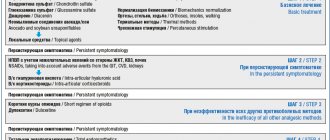Pharmacological properties of the drug Promethazine
Promethazine is a phenothiazine derivative, structurally and partially pharmacologically similar to chlorpromazine. The main pharmacological feature of promethazine is its pronounced antihistamine (H1-blocking) activity. It has a pronounced effect on the central nervous system, has pronounced sedative activity, enhances the effect of narcotic, hypnotics, analgesics and local anesthetics, lowers body temperature, prevents and eliminates vomiting. It has a moderate peripheral and central anticholinergic effect. The adrenolytic effect is very pronounced. When taken orally, it is well absorbed and, through various routes of administration, penetrates the BBB.
Promethazine
International name of the medicinal substance:
Promethazine The list of drugs containing the active substance Promethazine is given after the description.
Pharmacological action:
A phenothiazine drug with high antihistamine activity and a pronounced effect on the central nervous system.
It has a sedative, hypnotic, antiemetic, antipsychotic, hypothermic effect. Prevents and soothes hiccups. Prevents but does not eliminate histamine-mediated effects (including urticaria and pruritus). The anticholinergic effect causes a drying effect on the mucous membranes of the nasal and oral cavities. The antiemetic, anti-dizziness effect may be associated with a central anticholinergic effect. Reduces stimulation of vestibular receptors and inhibits the function of the labyrinth. The antiemetic effect may be due to the effect on the chemoreceptor trigger zone of the medulla oblongata. The sedative effect is due to inhibition of histamine-N-methyltransferase and blockade of central histaminergic receptors. It is also possible to block other CNS receptors, such as serotonin and acetylcholine; stimulation of alpha-adrenergic receptors indirectly weakens the stimulation of the reticular formation of the brain stem. The clinical effect begins to develop when administered orally - after 15-60 minutes, with intramuscular administration - 20 minutes, with intravenous administration - 3-5 minutes and continues for 6, sometimes 12 hours. Pharmacokinetics:
Quickly and well absorbed from Gastrointestinal tract. With different routes of administration, it penetrates the BBB (accumulates in the central nervous system in significant concentrations) and the placental barrier. Bonding with plasma proteins is 65-90%. Metabolized in the liver to form sulfoxides and demethylated promethazine derivatives. T1/2 when taken orally - 7-14 hours. It is excreted mainly by the kidneys, to a lesser extent - with bile.
Indications:
Allergic diseases (rash, rheumatism with a pronounced allergic component, pruritic dermatosis, prurigo, eczema, exudative diathesis, drug rash, serum sickness, angioedema, hay fever, bronchial asthma, anaphylactic shock, rheumatism with a pronounced allergic component, insect bites) , study of gastric secretion (to prevent complications when used as a stimulator of histamine secretion).
In anesthesiology: premedication, postoperative period, as a component of lytic mixtures used to enhance general anesthesia and hypothermia, the action of analgesics and local anesthetics; during artificial hibernation. In neurology: kinetosis, migraine, to reduce extrapyramidal disorders when using antipsychotic drugs (neuroleptics), chorea, encephalitis and other diseases of the central nervous system, accompanied by increased vascular permeability; alcoholic delirium, trigeminal neuralgia, Meniere's syndrome, dizziness, nausea and vomiting, hyperthermia in case of poisoning, sea and air sickness, psychoses, neuroses (excitement, anxiety, sleep disorders) - as part of complex therapy. In pediatrics: changes in the skin and mucous membranes of infants due to exudative diathesis, eczema, asthmatic bronchitis, false croup, allergic dermatitis, serum sickness. Contraindications:
Hypersensitivity (including to other phenothiazines), simultaneous use of MAO inhibitors, lactation period, early childhood (up to 3 months). Caution.
Obstruction of the bladder neck, prostatic hypertrophy with clinical manifestations, predisposition to urinary retention, epilepsy, open-angle or closed-angle glaucoma, coma, liver failure, jaundice, suppression of bone marrow function, cardiovascular diseases (severe angina, arterial hypertension, decompensated CHF, atrial fibrillation ), Reye's syndrome, pregnancy, children (up to 2 years) and old age. Side effects:
From the nervous system: sedation, dizziness, drowsiness, anxiety, psychomotor agitation, nightmares, increased frequency of sleep apnea;
rarely - disorientation, confusion, extrapyramidal disorders, increased convulsive activity (in children). From the senses: disturbance of accommodation and vision, noise or ringing in the ears. From the cardiovascular system: orthostatic hypotension (with intravenous administration), decreased blood pressure, tachycardia or bradycardia. From the digestive system: anesthesia of the oral mucosa, dry mouth (when taken orally), nausea, vomiting, cholestasis, constipation. From the respiratory system: dry nose, throat. From the urinary system: rarely - difficult or painful urination. Laboratory indicators: rarely - leukopenia, thrombocytopenia, agranulocytosis. Allergic reactions: urticaria, dermatitis, asthma. Local reactions: with intramuscular injection - painful infiltration at the injection site. Other: increased sweating, photosensitivity. Overdose. Symptoms: in children - agitation, anxiety, hallucinations, ataxia, athetosis, convulsions, mydriasis and immobility of the pupils, flushing of the facial skin, hyperthermia; then - vascular collapse, coma; in adults - lethargy, depression, coma; then - psychomotor agitation, convulsions. Treatment: gastric lavage, administration of activated carbon orally (during detoxification in the early stages after oral administration of the drug); according to indications - antiepileptic drugs, mechanical ventilation and other resuscitation measures, dialysis is ineffective. Interaction:
Enhances the effects of narcotic analgesics, hypnotics, anxiolytic (tranquilizers) and antipsychotic drugs (neuroleptics), as well as drugs for general anesthesia, local anesthetics, m-anticholinergic drugs and antihypertensive drugs (dose adjustment required).
Weakens the effect of amphetamine derivatives, m-cholinergic stimulants, anticholinesterase drugs, ephedrine, guanethidine, levodopa, dopamine. Barbiturates accelerate elimination and reduce activity. Beta-blockers increase (mutually) plasma concentrations (a pronounced decrease in blood pressure, arrhythmias, irreversible retinopathy, tardive dyskinesia are possible). Weakens the effect of bromocriptine and increases the concentration of prolactin in the blood serum. Tricyclic antidepressants and anticholinergic drugs enhance m-anticholinergic activity; ethanol, clonidine, and antiepileptic drugs increase central nervous system depression. MAO inhibitors (simultaneous administration is not recommended) and phenothiazine derivatives increase the risk of arterial hypotension and extrapyramidal disorders. Quinidine increases the likelihood of cardiodepressive effects. Myelotoxic drugs increase the manifestations of hematotoxicity of the drug. Special instructions:
During long-term treatment, it is necessary to systematically conduct a general blood test and evaluate liver function.
In the process of further treatment, the degree of restrictions is determined depending on individual tolerance. Together with narcotic analgesics, anxiolytics - for comprehensive preoperative preparation of patients, used under strict medical supervision. During treatment, the use of ethanol is prohibited. In old age, caution is necessary when administering high doses parenterally, because extrapyramidal disorders and acute urinary retention are possible. The use of promethazine in children under 2 years of age may be accompanied by an increased frequency of nocturnal apnea attacks. As an antiemetic drug, it should be used only for prolonged vomiting of known etiology. With long-term use, the risk of developing dental diseases (caries, periodontitis, candidiasis) increases due to a decrease in salivation. To prevent CNS depression, caffeine is recommended. May mask the ototoxic effect (tinnitus and dizziness) of co-administered drugs. Increases the need for riboflavin. The solution is not intended for intravenous and subcutaneous administration. Some dosage forms of promethazine contain sodium metabisulfite, which can cause allergic reactions (including anaphylactoid reactions) and bronchospasm. To prevent distortion of the results of skin prick tests for allergens, it is necessary to cancel 72 hours before allergy testing. During treatment, false positive pregnancy test results are possible. In the initial, individually determined period of treatment, care must be taken when driving vehicles and engaging in other potentially hazardous activities that require increased concentration and speed of psychomotor reactions. Preparations containing the active ingredient Promethazine:
Diprazine, Diprazina, Pipolzin, Pipolfen
The information provided in this section is intended for medical and pharmaceutical professionals and should not be used for self-medication. The information is provided for informational purposes only and cannot be considered official.
Use of the drug Promethazine
Inside after meals. Adults are prescribed 25 mg 2-3 times a day, children - in doses appropriate to age. A single oral dose for children aged 1–2 years is usually 2.5 mg, daily – 7.5–10 mg; at the age of 3–4 years: single - 5 mg, daily - 15 mg; 5–6 years: single dose – 7.5–10 mg, daily – 25–30 mg; 7–9 years: single dose - 10 mg, daily dose - 30 mg; 10–14 years: single dose - 15 mg, daily dose - 45 mg. To prevent motion sickness, it is prescribed orally once 1 hour before the trip: adults - 25-50 mg, children - 10-20 mg. Higher doses for adults orally: single - 75 mg, daily - 500 mg. In preparation for surgery, 25–50 mg is prescribed the night before to potentiate anesthesia along with other hypnotics. 2.5 hours before the start of the operation, 50 mg is administered intramuscularly along with other components of the lytic mixture; if necessary, this dose can be re-administered after 1 hour. When administering the drug intramuscularly to children of all age groups, the single dose is 0.5–1 mg/kg; administered intramuscularly 3–5 times a day. In severe and emergency cases, it can be administered once at a dose of 1–2 mg/kg. If intravenous administration is necessary, promethazine should be used at a dose of 0.15–0.3 mg/kg.
First aid for poisoning and overdose
What should be done in a situation if taking codeine syrup leads to poisoning. First aid depends on the duration of taking codeine-based tablets or syrup and the severity of the symptoms. The following measures must be taken:
- rinse the stomach with plenty of water, induce vomiting;
- let the victim take a sorbent - atoxyl, enterosgel, activated carbon, polysorb or another available drug;
- a mild condition may be relieved by taking a laxative;
- contact an ambulance or medical facility for further assistance.
If moderate or severe poisoning occurs, it is necessary to call an ambulance team as quickly as possible. To relieve symptoms, specialized equipment is needed to restore the respiratory process and medications to normalize heart rhythm.
Treatment for codeine addiction
Treatment of dependence on pharmaceutical drugs with codeine for cough lasts for 2-6 months and involves the following main stages.
- Detoxification of the body using infusion therapy. Depending on the severity of symptoms, active detoxification - hemodialysis - is also used.
- Stabilization of the patient’s health status using analgesics, antipsychotics, sedatives, vitamin complexes.
- Symptomatic treatment of existing and acquired diseases due to drug use.
- The final stage is psychotherapy, attending group trainings for further adaptation in society.
The need to use certain therapeutic methods and procedures is determined by the attending narcologist.
Cough syrup containing codeine is primarily a medicine. But if you abuse the drug, you can get codeine addiction. Quitting taking a codeine-containing drug in any form on your own is difficult and beyond the capabilities of most addicts. Narcologists recommend undergoing therapy exclusively in a hospital setting under the supervision of qualified medical personnel. The clinic will provide medication and psychological support, which will quickly normalize the patient’s physical and psychological condition.
Leave a request for a free consultation with a specialist
We will contact you as soon as possible
- — Anonymous
- - For free
- — Around the clock
Article prepared by an expert
Terekhova Anna Vladimirovna
psychologist-consultant on socio-psychological work with addicted clients and their families. More than 9 years of experience.
Similar articles:
Can an addict stop using drugs forever?
How long does amphetamine stay in the blood?
Anxiety disorders and panic attacks due to drug addiction and alcoholism
How to get an alcoholic out of binge drinking
Female alcoholism
One comment on “What syrups contain codeine”
- Olga:
December 26, 2022 at 07:14 pm
Recently, I have been experiencing unimaginable trepidation when I comprehend these publications
Answer









